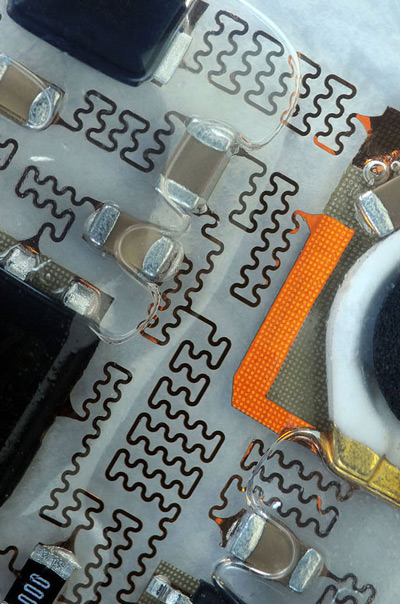Stick-on electronic patches for health monitoring
April 7, 2014
Engineers at the University of Illinois at Urbana-Champaign and Northwestern University have developed soft, thin stick-on patches that stretch and move with the skin, using commercially available, off-the-shelf chip-based electronics for sophisticated wireless health monitoring.
The patches stick to the skin like a temporary tattoo and incorporate a unique microfluidic construction, with wires folded like origami to allow the patch to bend and flex without being constrained by the rigid electronics components. The patches could wirelessly send updates to your cellphone or computer and could revolutionize clinical monitoring such as EKG and EEG testing — no bulky wires, pads, or tape needed.
“We designed this device to monitor human health 24/7, but without interfering with a person’s daily activity,” said Yonggang Huang, the Northwestern University professor who co-led the work with Illinois professor John A. Rogers. “It is as soft as human skin and can move with your body, but at the same time it has many different monitoring functions.”
The researchers did a side-by-side comparison with traditional EKG and EEG monitors and found the wireless patch performance equaled that of conventional sensors, while being significantly more comfortable for patients. That’s crucial for long-term monitoring, situations such as stress tests or sleep studies when the outcome depends on the patient’s ability to move and behave naturally, or for patients with fragile skin, such as premature newborns.
The design is described in the April 4 issue of Science.
Microfluidics and stretchable wires
Rogers’ group at Illinois previously demonstrated skin electronics made of very tiny, ultrathin, specially designed and printed components.
“Our original epidermal devices exploited specialized device geometries — super thin, structured in certain ways,” Rogers said. “But chip-scale devices, batteries, capacitors and other components must be re-formulated for these platforms. Our new concepts in microfluidics and origami interconnects enable compatibility with commercial off-the-shelf parts for accelerated development, reduced costs, and expanded options in device types.”
The multi-university team turned to soft microfluidic designs to address the challenge of integrating relatively big, bulky chips with the soft, elastic base of the patch. The patch is constructed of a thin elastic envelope filled with fluid. The chip components are suspended on tiny raised support points, bonding them to the underlying patch but allowing the patch to stretch and move.
One of the biggest engineering feats of the patch is the design of the tiny, squiggly wires connecting the electronics components, including radios, power inductors, and sensors. The serpentine-shaped wires are folded like origami, so that no matter which way the patch bends, twists or stretches, the wires can unfold in any direction to accommodate the motion. Since the wires stretch, the chips don’t have to.
Fitness tracking
Skin-mounted devices could give those interested in fitness tracking a more complete and accurate picture of their activity level.
“When you measure motion on a wristwatch type device, your body is not very accurately or reliably coupled to the device,” said Rogers, a Swanlund Professor of Materials Science and Engineering at the U. of I. “Relative motion causes a lot of background noise. If you have these skin-mounted devices and an ability to locate them on multiple parts of the body, you can get a much deeper and richer set of information than would be possible with devices that are not well coupled with the skin.”
The researchers hope that their sophisticated, integrated sensing systems could also could help identify problems before the patient may be aware. For example, according to Rogers, data analysis could detect motions associated with Parkinson’s disease at its onset.
The National Security Science and Engineering Faculty Fellowship of Energy, the Korean Foundation for International Cooperation of Science and Technology, and the Department of Energy supported this work.
Rogers directs the Frederick Seitz Materials Research Laboratory at Illinois and also is affiliated with the Beckman Institute for Advanced Science and Technology and the departments ofchemistry, of mechanical science and engineering, of bioengineering and of electrical and computer engineering.
Huang is the Joseph Cummings Professor of Civil and Environmental Engineering and Mechanical Engineering at Northwestern’s McCormick School of Engineering and Applied Science.
Abstract of Science paper
When mounted on the skin, modern sensors, circuits, radios, and power supply systems have the potential to provide clinical-quality health monitoring capabilities for continuous use, beyond the confines of traditional hospital or laboratory facilities. The most well-developed component technologies are, however, broadly available only in hard, planar formats. As a result, existing options in system design are unable to effectively accommodate integration with the soft, textured, curvilinear, and time-dynamic surfaces of the skin. Here, we describe experimental and theoretical approaches for using ideas in soft microfluidics, structured adhesive surfaces, and controlled mechanical buckling to achieve ultralow modulus, highly stretchable systems that incorporate assemblies of high-modulus, rigid, state-of-the-art functional elements. The outcome is a thin, conformable device technology that can softly laminate onto the surface of the skin to enable advanced, multifunctional operation for physiological monitoring in a wireless mode.

